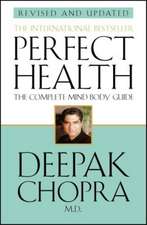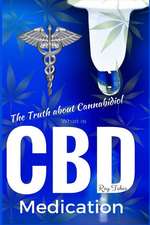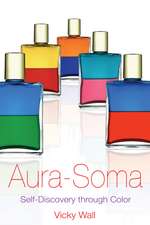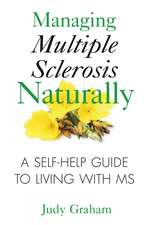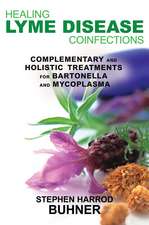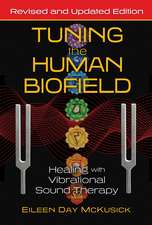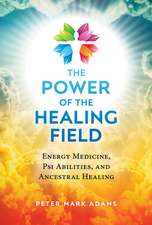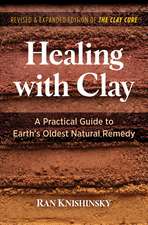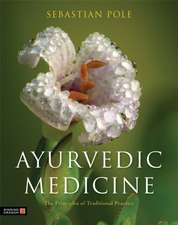Herbs for Healthy Aging: Natural Prescriptions for Vibrant Health
Autor David Hoffmann FNIMH, AHGen Limba Engleză Paperback – 13 feb 2014
Preț: 97.65 lei
Preț vechi: 121.16 lei
-19% Nou
Puncte Express: 146
Preț estimativ în valută:
18.69€ • 20.31$ • 15.71£
18.69€ • 20.31$ • 15.71£
Carte disponibilă
Livrare economică 04-16 aprilie
Preluare comenzi: 021 569.72.76
Specificații
ISBN-13: 9781620552216
ISBN-10: 1620552213
Pagini: 384
Dimensiuni: 152 x 229 x 25 mm
Greutate: 0.46 kg
Ediția:3rd Edition, New Edition of Herbal Prescriptions after 50
Editura: Inner Traditions/Bear & Company
Colecția Healing Arts Press
ISBN-10: 1620552213
Pagini: 384
Dimensiuni: 152 x 229 x 25 mm
Greutate: 0.46 kg
Ediția:3rd Edition, New Edition of Herbal Prescriptions after 50
Editura: Inner Traditions/Bear & Company
Colecția Healing Arts Press
Notă biografică
David Hoffmann, FNIMH, AHG, has been a clinical medical herbalist since 1979. A Fellow of Britain’s National Institute of Medical Herbalists, he is one of the founding members of the American Herbalists Guild and the author of 17 books, including Medical Herbalism, The Complete Illustrated Holistic Herbal, and The Herbal Handbook. He teaches herbal medicine throughout the English-speaking world and lives in California.
Extras
Chapter 2
The Cardiovascular System
PLANTS STILL MAINTAIN a central position today in orthodox medical treatment of various heart problems. Herbs containing constituents called cardiac glycosides are used worldwide for treating heart failure and arrhythmias. These herbs help strengthen the heartbeat and normalize its rate. Foxglove is the source of the widely used medication digoxin, which contains stimulating digitalis glycosides. However, herbal remedies nurture the heart in deeper ways as well. The cardiovascular tonics offer a range of remedies uniquely suited for treating problems of the heart and blood vessels. While they cannot boast the dramatic, rapid, often lifesaving effects of many of the synthetic drugs on the market today, they have a definite advantage in addressing the chronic degenerative conditions often found among people as they age.
CARDIOVASCULAR PROBLEMS
Hypertension
There are more than thirty-five million hypertensives in the United States. Twice as many African Americans as Caucasians are afflicted, but the reasons for this are not understood. A common problem in our culture, hypertension (or high blood pressure) is rare in cultures that are relatively untouched by the Western lifestyle. Lifestyle plays a major role in causing and maintaining hypertension. Dietary, psychological, and social factors must all be addressed for any real change to occur.
Hypertension is typically free of symptoms until complications arise. The symptoms associated with the condition can be caused by other problems as well and include dizziness, flushed face, headache, fatigue, nosebleed, and nervousness. Observable changes in retinal blood vessels are diagnostic indicators of the degree of damage caused to the body by hypertension. Diagnosis includes finding that both systolic and diastolic blood pressure are usually, but not always, higher than normal; other causes must be excluded. Hypertension is considered to be shown by a blood pressure reading of greater than 140/90, but “normal” must be considered as a range rather than as one specific figure for the whole population.
Temporary increase in blood pressure is a common and normal response to the ups and downs of life. Sustained hypertension is caused by increased peripheral vascular resistance. This is initiated by increased arteriolar tone and leads to the damaging structural changes of arteriosclerosis.
A number of herbs have a reputation as being specific for hypertension, usually because of their impact on one or another of the processes involved in the condition’s development. The hypotensives, remedies that have been found by generations of herbalists to reduce elevated blood pressure, fit this description. The most important such plant remedy known to Western medicine is hawthorn, but there are many more. Included here is a partial list:
black cohosh
black haw
blue cohosh
buckwheat
cramp bark
eleuthero
fenugreek
garlic
hawthorn berries
linden
mistletoe
motherwort
nettle
onion
parsley
passionflower
skullcap
valerian
vervain
yarrow (European)
Each of these hypotensives has other effects that are known as secondary actions; thus the herbalist can select remedies that address the individual’s range of needs, not merely the hypertension. Following is a selection of safe and effective hypotensives grouped by their other actions.
• Adaptogen: Eleuthero
• Anti-inflammatory: black cohosh, blue cohosh, buckwheat, valerian
• Antispasmodic: black cohosh, cramp bark, linden, motherwort,passionflower, skullcap, valerian
• Bitter: yarrow
• Carminative: parsley, valerian
• Demulcent: fenugreek
• Diaphoretic: garlic, linden, onion, vervain, yarrow
• Diuretic: linden, nettle, parsley, yarrow
• Expectorant: fenugreek, garlic, onion, parsley
• Hepatic: onion, vervain
• Nervine: black cohosh, cramp bark, linden, motherwort, passionflower, skullcap, valerian, vervain
Where hypertension is associated with water retention, more emphasis will be placed upon the diuretic herbs listed above; where stress is a major factor, consider the adaptogens and nervines, and so forth. Here is a safe and effective sample combination that will gradually normalize the blood pressure:
• hawthorn - 2 parts
• linden blossom -1 part
• yarrow - 1 part
• cramp bark - 1 part
• valerian - 1 part
As tincture: take 1 tsp (5 ml) of this mixture three times a day.
As dried herb: infuse 2 tsp to a cup and drink three times a day.
The ingredients in this mixture are all hypotensives but also offer a well-rounded range of relevant secondary actions. Hawthorn is also an excellent cardiac tonic and thus plays a fundamental role in strengthening and toning the whole cardiovascular system. Diuretics such as yarrow help remove any excessive buildup of water in the body and overcome any decrease in renal blood flow that may accompany the hypertension. Peripheral vasodilators will lessen high resistance within the peripheral blood vessels, thus increasing the total volume of the system and so lowering the pressure within it. The nervines valerian, linden, and cramp bark address any tension and anxiety present. Antispasmodics will ease peripheral resistance to blood flow by gently relaxing both the muscles that the vessels pass through and the muscular coat of the vessels themselves. Cramp bark is probably the most effective and safe of these herbs; valerian is a second.
Other plants might be added as well, depending upon the individual’s specific symptom picture. For example, if palpitations are present, add motherwort. If stress is a factor, increase the nervine content and possibly include an adaptogen. An alternative prescription for hypertension with stress as a major factor might be the following:
• hawthorn - 2 parts
• linden blossom - 1 part
• yarrow - 1 part
• eleuthero - 1 part
• skullcap - 1 part
• cramp bark - 1 part
• valerian - 1 part
As tincture: take 1 tsp (5 ml) of this mixture three times a day.
As dried herb: infuse 2 tsp to a cup and drink three times a day.
Another example might take into account heart palpitations (tachycardia). If the cause of the palpitations is not heart disease as such, a prescription for hypertension with palpitations might be the following:
• hawthorn - 2 parts
• motherwort - 2 parts
• linden blossom - 1 part
• yarrow - 1 part
• cramp bark - 1 part
• valerian - 1 part
As tincture: take I tsp (5 ml) of this mixture three times a day.
As dried herb: infuse 2 tsp to a cup and drink three times a day.
The Cardiovascular System
PLANTS STILL MAINTAIN a central position today in orthodox medical treatment of various heart problems. Herbs containing constituents called cardiac glycosides are used worldwide for treating heart failure and arrhythmias. These herbs help strengthen the heartbeat and normalize its rate. Foxglove is the source of the widely used medication digoxin, which contains stimulating digitalis glycosides. However, herbal remedies nurture the heart in deeper ways as well. The cardiovascular tonics offer a range of remedies uniquely suited for treating problems of the heart and blood vessels. While they cannot boast the dramatic, rapid, often lifesaving effects of many of the synthetic drugs on the market today, they have a definite advantage in addressing the chronic degenerative conditions often found among people as they age.
CARDIOVASCULAR PROBLEMS
Hypertension
There are more than thirty-five million hypertensives in the United States. Twice as many African Americans as Caucasians are afflicted, but the reasons for this are not understood. A common problem in our culture, hypertension (or high blood pressure) is rare in cultures that are relatively untouched by the Western lifestyle. Lifestyle plays a major role in causing and maintaining hypertension. Dietary, psychological, and social factors must all be addressed for any real change to occur.
Hypertension is typically free of symptoms until complications arise. The symptoms associated with the condition can be caused by other problems as well and include dizziness, flushed face, headache, fatigue, nosebleed, and nervousness. Observable changes in retinal blood vessels are diagnostic indicators of the degree of damage caused to the body by hypertension. Diagnosis includes finding that both systolic and diastolic blood pressure are usually, but not always, higher than normal; other causes must be excluded. Hypertension is considered to be shown by a blood pressure reading of greater than 140/90, but “normal” must be considered as a range rather than as one specific figure for the whole population.
Temporary increase in blood pressure is a common and normal response to the ups and downs of life. Sustained hypertension is caused by increased peripheral vascular resistance. This is initiated by increased arteriolar tone and leads to the damaging structural changes of arteriosclerosis.
A number of herbs have a reputation as being specific for hypertension, usually because of their impact on one or another of the processes involved in the condition’s development. The hypotensives, remedies that have been found by generations of herbalists to reduce elevated blood pressure, fit this description. The most important such plant remedy known to Western medicine is hawthorn, but there are many more. Included here is a partial list:
black cohosh
black haw
blue cohosh
buckwheat
cramp bark
eleuthero
fenugreek
garlic
hawthorn berries
linden
mistletoe
motherwort
nettle
onion
parsley
passionflower
skullcap
valerian
vervain
yarrow (European)
Each of these hypotensives has other effects that are known as secondary actions; thus the herbalist can select remedies that address the individual’s range of needs, not merely the hypertension. Following is a selection of safe and effective hypotensives grouped by their other actions.
• Adaptogen: Eleuthero
• Anti-inflammatory: black cohosh, blue cohosh, buckwheat, valerian
• Antispasmodic: black cohosh, cramp bark, linden, motherwort,passionflower, skullcap, valerian
• Bitter: yarrow
• Carminative: parsley, valerian
• Demulcent: fenugreek
• Diaphoretic: garlic, linden, onion, vervain, yarrow
• Diuretic: linden, nettle, parsley, yarrow
• Expectorant: fenugreek, garlic, onion, parsley
• Hepatic: onion, vervain
• Nervine: black cohosh, cramp bark, linden, motherwort, passionflower, skullcap, valerian, vervain
Where hypertension is associated with water retention, more emphasis will be placed upon the diuretic herbs listed above; where stress is a major factor, consider the adaptogens and nervines, and so forth. Here is a safe and effective sample combination that will gradually normalize the blood pressure:
• hawthorn - 2 parts
• linden blossom -1 part
• yarrow - 1 part
• cramp bark - 1 part
• valerian - 1 part
As tincture: take 1 tsp (5 ml) of this mixture three times a day.
As dried herb: infuse 2 tsp to a cup and drink three times a day.
The ingredients in this mixture are all hypotensives but also offer a well-rounded range of relevant secondary actions. Hawthorn is also an excellent cardiac tonic and thus plays a fundamental role in strengthening and toning the whole cardiovascular system. Diuretics such as yarrow help remove any excessive buildup of water in the body and overcome any decrease in renal blood flow that may accompany the hypertension. Peripheral vasodilators will lessen high resistance within the peripheral blood vessels, thus increasing the total volume of the system and so lowering the pressure within it. The nervines valerian, linden, and cramp bark address any tension and anxiety present. Antispasmodics will ease peripheral resistance to blood flow by gently relaxing both the muscles that the vessels pass through and the muscular coat of the vessels themselves. Cramp bark is probably the most effective and safe of these herbs; valerian is a second.
Other plants might be added as well, depending upon the individual’s specific symptom picture. For example, if palpitations are present, add motherwort. If stress is a factor, increase the nervine content and possibly include an adaptogen. An alternative prescription for hypertension with stress as a major factor might be the following:
• hawthorn - 2 parts
• linden blossom - 1 part
• yarrow - 1 part
• eleuthero - 1 part
• skullcap - 1 part
• cramp bark - 1 part
• valerian - 1 part
As tincture: take 1 tsp (5 ml) of this mixture three times a day.
As dried herb: infuse 2 tsp to a cup and drink three times a day.
Another example might take into account heart palpitations (tachycardia). If the cause of the palpitations is not heart disease as such, a prescription for hypertension with palpitations might be the following:
• hawthorn - 2 parts
• motherwort - 2 parts
• linden blossom - 1 part
• yarrow - 1 part
• cramp bark - 1 part
• valerian - 1 part
As tincture: take I tsp (5 ml) of this mixture three times a day.
As dried herb: infuse 2 tsp to a cup and drink three times a day.
Cuprins
Foreword by Cheri Quincy, D.O.
Introduction
Why Now?
Holistic Medicine: The Healing Context
What Herbal Medicine Can Contribute
But Do Herbs Really Work?
The “Illness” of Health Care
Preventive Care
1 The Digestive System
The Healthy Digestive System
The Aging Digestive System
Herbal Actions
Keeping the Digestive System Healthy
Gastrointestinal Problems--Common and Serious
Problems of the Upper Digestive Tract
The Aging Colon and Its Problems
The Aging Liver and Its Problems
The Aging Gallbladder and Its Problems
2 The Cardiovascular System
Herbal Actions
Keeping the Cardiovascular System Healthy
Factors Contributing to Heart Disease
Cardiovascular Problems
3 The Pulmonary System
Herbal Actions
Pulmonary Problems
4 The Upper Respiratory System
Upper Respiratory Problems
5 The Nervous System
Herbal Actions
Stress and Its Impact on the Nervous System
Managing Stress
Nervous System Problems
6 The Urinary System
Signs of Kidney Disease
Herbal Actions
Keeping the Kidneys Healthy
Urinary Problems
7 The Reproductive System
The Female Reproductive System/Female Sexuality
Herbal Actions for the Female Reproductive System
Problems Specific to Women
The Male Reproductive System/Male Sexuality
Herbal Actions for the Male Reproductive System
Problems Specific to Men
8 The Musculoskeletal System
Herbal Actions
Musculoskeletal Problems
9 The Skin and Hair
Skin and Its Functions
Aging Skin
Herbal Actions
Skin Problems
Herbal “First Aid” for the Skin
The Hair
10 The Immune System
Herbal Actions
Immunological Actions
Immune System Problems
11 The Endocrine System
The Adrenal Glands
The Pancreas
The Thyroid Gland
12 Herbal Medicine Making
Herbal Tea
Tincture
Dry Herb Preparations
Formulations for the Skin
13 Materia Medica
Useful Internet Resources
Bibliography
Index
Introduction
Why Now?
Holistic Medicine: The Healing Context
What Herbal Medicine Can Contribute
But Do Herbs Really Work?
The “Illness” of Health Care
Preventive Care
1 The Digestive System
The Healthy Digestive System
The Aging Digestive System
Herbal Actions
Keeping the Digestive System Healthy
Gastrointestinal Problems--Common and Serious
Problems of the Upper Digestive Tract
The Aging Colon and Its Problems
The Aging Liver and Its Problems
The Aging Gallbladder and Its Problems
2 The Cardiovascular System
Herbal Actions
Keeping the Cardiovascular System Healthy
Factors Contributing to Heart Disease
Cardiovascular Problems
3 The Pulmonary System
Herbal Actions
Pulmonary Problems
4 The Upper Respiratory System
Upper Respiratory Problems
5 The Nervous System
Herbal Actions
Stress and Its Impact on the Nervous System
Managing Stress
Nervous System Problems
6 The Urinary System
Signs of Kidney Disease
Herbal Actions
Keeping the Kidneys Healthy
Urinary Problems
7 The Reproductive System
The Female Reproductive System/Female Sexuality
Herbal Actions for the Female Reproductive System
Problems Specific to Women
The Male Reproductive System/Male Sexuality
Herbal Actions for the Male Reproductive System
Problems Specific to Men
8 The Musculoskeletal System
Herbal Actions
Musculoskeletal Problems
9 The Skin and Hair
Skin and Its Functions
Aging Skin
Herbal Actions
Skin Problems
Herbal “First Aid” for the Skin
The Hair
10 The Immune System
Herbal Actions
Immunological Actions
Immune System Problems
11 The Endocrine System
The Adrenal Glands
The Pancreas
The Thyroid Gland
12 Herbal Medicine Making
Herbal Tea
Tincture
Dry Herb Preparations
Formulations for the Skin
13 Materia Medica
Useful Internet Resources
Bibliography
Index
Recenzii
“Medical statistics clearly show that Americans are the most heavily medicated people in the world. In spite of this (or possibly because of this) we rank far below many other first world countries in life expectancy and far above in cancer rates, levels of obesity, and many other chronic degenerative diseases.
As our population ages many more people are realizing that in order to stay healthy into old age we need to become proactive, improving our diets and lifestyle choices, reducing stress, and becoming more knowledgeable about our health and medicine. One way we can help to prevent disease and enhance wellness is the intelligent use of herbs.
Because few Americans grew up using plants as medicine, educating oneself as to their safe and rational use is essential. With so many books, websites, and magazines publishing information on herbs and natural health, how does one discern accurate information from the fraudulent? One answer is David Hoffmann’s new book, Herbs for Healthy Aging.
Hoffmann is one of the Western world’s most respected clinical herbalists, and he offers the reader safe, effective, and relevant treatments for many of the ills that come with increasing age. If you want to prevent senior moments, menopausal symptoms, prostatic enlargement, and circulatory problems, some of the answers you are seeking can be found within these pages.”
“Herbal medicine can be as simple as brewing a pot of tea. However, knowing which herbs to use and how to use them requires experience, which Hoffmann amply provides. Herbs for Healthy Aging gives authoritative answers to most of the commonly asked questions about when and how to use herbs medicinally.”
“Herbs for Healthy Aging is an invaluable resource.”
As our population ages many more people are realizing that in order to stay healthy into old age we need to become proactive, improving our diets and lifestyle choices, reducing stress, and becoming more knowledgeable about our health and medicine. One way we can help to prevent disease and enhance wellness is the intelligent use of herbs.
Because few Americans grew up using plants as medicine, educating oneself as to their safe and rational use is essential. With so many books, websites, and magazines publishing information on herbs and natural health, how does one discern accurate information from the fraudulent? One answer is David Hoffmann’s new book, Herbs for Healthy Aging.
Hoffmann is one of the Western world’s most respected clinical herbalists, and he offers the reader safe, effective, and relevant treatments for many of the ills that come with increasing age. If you want to prevent senior moments, menopausal symptoms, prostatic enlargement, and circulatory problems, some of the answers you are seeking can be found within these pages.”
“Herbal medicine can be as simple as brewing a pot of tea. However, knowing which herbs to use and how to use them requires experience, which Hoffmann amply provides. Herbs for Healthy Aging gives authoritative answers to most of the commonly asked questions about when and how to use herbs medicinally.”
“Herbs for Healthy Aging is an invaluable resource.”
Descriere
A guide to herbal remedies that promote longevity, restore the body’s systems, treat chronic conditions, and maintain natural health.

